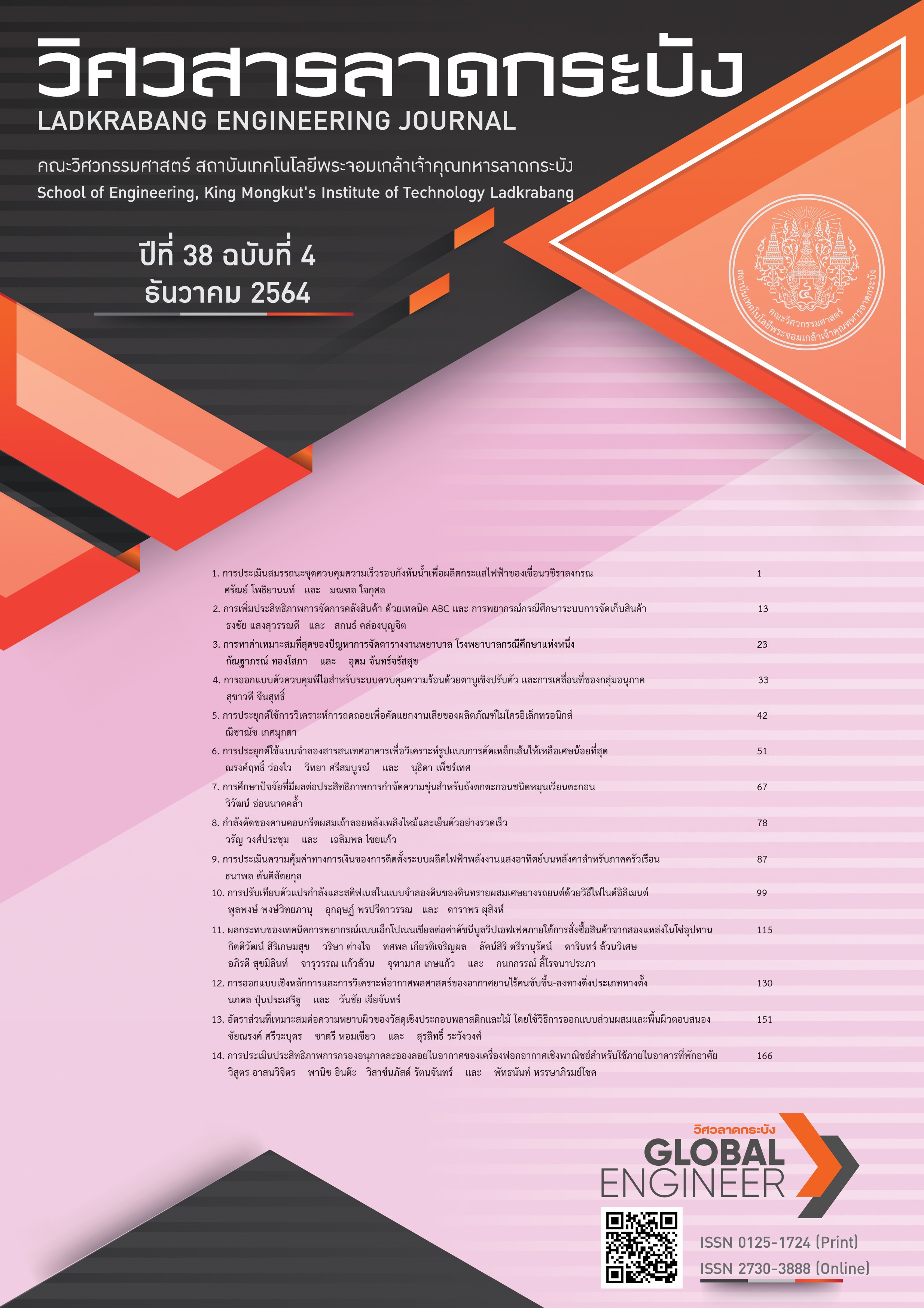การศึกษาปัจจัยที่มีผลต่อประสิทธิภาพการกำจัดความขุ่นสำหรับถังตกตะกอนชนิดหมุนเวียนตะกอน
คำสำคัญ:
ถังตกตะกอนชนิดหมุนเวียนตะกอน, ใบกวนตะกอน, ใบกวาดตะกอน, ประสิทธิภาพการกำจัดความขุ่น, ระบบผลิตน้ำประปาบทคัดย่อ
บทความนี้ศึกษาปัจจัยที่มีผลต่อประสิทธิภาพการกำจัดความขุ่นของถังตกตะกอนชนิดหมุนเวียนตะกอน โดยการควบคุมอัตราการเติมสารส้ม 14 มิลลิกรัม/ลิตรและอัตราผิวน้ำล้น 3.2 เมตร/ชั่วโมง ผลการทดลองเปรียบเทียบประสิทธิภาพการกำจัดความขุ่นของความเร็วรอบใบกวนตะกอน 100, 110, 120 และ 130 รอบ/ชั่วโมง ตามลำดับ และความเร็วรอบใบกวาดตะกอน 0.65, 0.75, 0.85 และ 0.95 รอบ/ชั่วโมง ตามลำดับ ผลการทดลองพบว่า ความเร็วรอบของใบกวนตะกอน ความเร็วรอบของใบกวาดตะกอนและผลร่วมของทั้ง 2 ตัวแปร ส่งผลต่อประสิทธิภาพการกำจัดความขุ่นอย่างมีนัยสำคัญ การควบคุมความเร็วรอบของใบกวนตะกอนและใบกวาดตะกอน จะต้องควบคุมให้ค่าความเร็วเกรเดียนต์ของใบกวนตะกอนและใบกวาดตะกอนให้ลดหลั่นกันอย่างเหมาะสม (Tapered Velocity Gradient) โดยความเร็วรอบของใบกวนตะกอนที่มีค่าสูง จะต้องควบคุมให้ความเร็วรอบของใบกวาดตะกอนให้มีค่าต่ำ และความเร็วรอบขอบใบกวนตะกอนที่มีค่าต่ำ จะต้องเพิ่มความเร็วรอบของใบกวาดตะกอนให้มีค่าสูง เพื่อให้อนุภาคตะกอนสามารถรวมตัวกันและไม่เกิดการแตกตัว จะส่งผลให้สามารถกำจัดความขุ่นได้ดี จุดที่มีค่าประสิทธิภาพการกำจัดความขุ่นสูงที่สุด คือ ความเร็วรอบของใบกวนตะกอนและใบกวาดตะกอน 120 และ 0.65 รอบ/ชั่วโมง ตามลำดับ มีค่าความเร็วเกรเดียนต์ของใบกวนตะกอนและใบกวาดตะกอน 33.2 และ 14.7 วินาที-1 มีค่าประสิทธิภาพการกำจัดความขุ่นเท่ากับ 93.19 ± 1.51%
References
American Water Work Association and American Society of Civil Engineers, “Mixing, Coagulation and Flocculation,” in Water treatment plant design, 4th ed., London, UK: McGraw-Hill, 1990, ch. 6, sec. 6.4-6.5, pp. 112–129.
Y. Tantipalakul, K. Palawatwichai, T. Detchakan and J. Khaisan, “The study of optimal coagulants for water treatment process of Metropolitan Waterworks Authority,” Burabha Journal of Science, vol. 23, no.1, pp. 207–220, Jan., 2018.
S. Eardprapan, “Investigation of Operating Criteria and Efficiency of Sludge Blanket Clarifier at Pangpuay Water Treatment Plant, Rachaburi Province,” M.E. thesis, Dept. Environ. Eng., Kasetsart Univ., Bangkok, Thailand, 2002.
S. Tasutin, “Turbidity Removal from Surface Water by Aluminum Chlorohydrate,” M.S. thesis, Dept. Environ. Sci., Chulalongkorn Univ., Bangkok, Thailand, 2009.
V. Poonsawatt and T. Ratpukdi, “Optimum Alum Dosage for High Turbidity Removal in Water Treatment Plant,” presented at The 20th National Graduate Research Conference, Khon Kaen, Thailand, Mar. 15, 2019 pp. 98–104.
C. Ruenmai, “Factors Affect Quality of Water Supply of Four Communities in Nonthai District, Nakorn Ratchasrima,” M.E. thesis, Dept. Civ. Eng., Suranari Univ. Technol., Nakornratchasrima, Thailand, 2012.
A. Baghvand, A. D. Zand, N. Mehrdadi and A. Karbassi, “Optimizing Coagulation Process for Low to High Turbidity Waters Using Aluminum and Iron Salts,” American Journal of Environmental Science, vol. 6, no. 5, pp. 442–448, 2010.
Z. Zhang, D. Liu, D. Hu, D. Li, X. Ren, Y. Cheng and Z. Luan, “Effect of Slow-Mixing on the Coagulation Performance of Polyaluminum Chloride(PACl),” Chinese Journal of Chemical Engineering, vol. 21, no. 3, pp. 318–323, 2013, doi: 10.1016/S1004-9541(13)60463-2.
M.A. Yukselen and J. Gregory, “The Reversibility of Floc Breakage,” International Journal of Mineral Processing , vol. 73, no. 2–3, pp. 251–259, 2004, doi: 10.1016/S0301-7516(03)00077-2.
V. Thunthithum, “Turbidity Removal by Solids Recirculation Clarifier,” M.E. thesis, Dept. Environ. Eng., Chulalongkorn Univ., Bangkok, Thailand, 1994.
L. Thumkarun, “Effect of Paddle on Turbidity Removal by Solids Recirculation Clarifier,” M.E. thesis, Dept. Environ. Eng., Chulalongkorn Univ., Bangkok, Thailand, 1993.
S. Cheyakul, “Control Parameter of Tapered Flocculation,” M.E. thesis, Dept. Sanit. Eng., Chulalongkorn Univ., Bangkok, Thailand, 1988.
C. C. Dorea, “Coagulant-based emergency water treatment,” Desalination, vol. 248, no. 1–3, pp. 83–90, May, 2009, doi: 10.1016/j.desal.2008.05.041.
A. C. Twort, D. D. Ratnayaka and M. J. Brandt, “Storage, Clarification and Filtration of Water,” in Water supply, 5th ed., Oxford, UK: Butterworth-Heinamann, 2006, ch. 7, sec. 7.13, pp. 267–369.
Who Health Organization, “Acceptability Aspects: Taste, Odour and Apparence,” in Guidelines for Drinking-Water Quality, 4th ed., Geneva, Switzerland: WHO press, 2011, ch. 10, sec. 10.1, pp. 219–230.
P. T. Spicer, W. Keller and S. E. Pratsinis, “The Effect of Impeller Type on Floc Size and Structure
during Shear-Induced Flocculation,” Journal of Colloid and Interface Science, vol. 184, no. 1, pp. 112–122, 1996, doi: 10.1006/jcis.1996.0601.
S. Intrto, “Effect of pulsation rate, surface overflow rate and suction height on turbidity removal efficiency of pulsator clarifier,” M.S. thesis, Dept. Sanit. Eng., Mahidol Univ., Nakorn Pathom, Thailand, 2005.
Downloads
เผยแพร่แล้ว
How to Cite
ฉบับ
บท
License
บทความที่ได้รับการตีพิมพ์เป็นลิขสิทธิ์ของคณะวิศวกรรมศาสตร์ สถาบันเทคโนโลยีพระจอมเกล้าเจ้าคุณทหารลาดกระบัง
ข้อความที่ปรากฏในบทความแต่ละเรื่องในวารสารวิชาการเล่มนี้เป็นความคิดเห็นส่วนตัวของผู้เขียนแต่ละท่านไม่เกี่ยวข้องกับสถาบันเทคโนโลยีพระจอมเกล้าเจ้าคุณทหารลาดกระบัง และคณาจารย์ท่านอื่นๆในสถาบันฯ แต่อย่างใด ความรับผิดชอบองค์ประกอบทั้งหมดของบทความแต่ละเรื่องเป็นของผู้เขียนแต่ละท่าน หากมีความผิดพลาดใดๆ ผู้เขียนแต่ละท่านจะรับผิดชอบบทความของตนเองแต่ผู้เดียว






